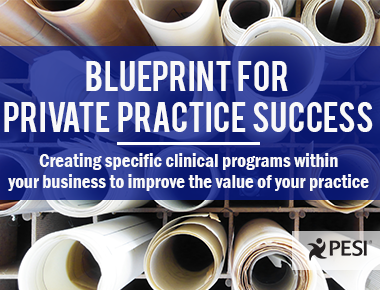Blueprint for Private Practice Success
Creating specific clinical programs withinyour business to improve the value of your practice

Are you a dreamer or a worrier? Do you lie in bed worrying about where your next client will come from? Or perhaps you positively envision a new idea for your clinical practice and the wheels spin so much that you can’t seem to stop dreaming of the possibilities. Only then are you frozen, either from fear of negative consequence or sheer lack of motivation as other priorities take form…And, the hours go forth, days go by, months, and even years. You promised yourself you’d get started, but your dreams still rest in a faint albeit familiar vision, and your worries only temporarily abate, finally returning like the wax and wane of waves circling high and low tides.
“I want that ideal client! I can’t manage the administrative while providing good therapy! Taxes? Why me? Why so much money? I didn’t plan for this! Wait, I need to protect assets? I have to think about my financial future when it’s challenging enough to meet my financial goals in the present. I am competent clinically. I am lucky, but not satisfied! I am always trying to make it better. Or, I am just trying to make it in practice, period.” The thoughts run through your mind, with no solutions in sight. There’s no getting around it, and you know you have to go “through” it! Just like your clients. Yet, how? How do you make it in this business of providing mental health care?
Every building has its blueprint before it becomes built. The blueprint is a building’s plan. It’s both general and detailed. And, it carries with it, many changes until perfected, even at the very moment it’s actually getting completed! If you are entering or already in private practice, your blueprint not only consists of your clinical training, it needs to include a solid plan for creating, growing and sustaining your business. You need a private practice business plan! One that resonates with who you are as a clinician, what services you provide, to whom you provide these services, how you receive and retain clients, and many other relevant aspects related to achieving success while operating your private practice.
So what are the main elements of a solid private practice business plan, you ask? Here they are along with a short definition:
- Executive Summary — A summation of your overall plan
- Mission Statement — Your aim and target in what you do
- Tag Line/Logo — Your brief motto and visual brand
- Four C’s Analysis — Capabilities, Challenges, Chances, Concerns
- Services — Who, what, when, where, why, and how
- Networking & Marketing — Business to business, in-person, and online
- Practice Administration — Professional supports
- Financial Management & Growth — Banking, expenses & income, taxes, saving
- Diversity Inclusion — Statement of human inclusion and reflection of practice therein
- Professional Growth — Continuing professional education
- Personal Wellness & Work/Life Balance — Hobbies, and social outlets
- References & Resources — Books, articles, and community resources
FREE DOWNLOAD: Private Practice Business Plan Template – Your Blueprint For Success
Begin working on your own blueprint for success! Your plan is meaningful and creative. It’s general and specific. There’s no right or wrong way to do it. Just make sure you do it! A good friend once told me, “plan your work” (that’s the blueprint or business plan element!) and then “work your plan!” That’s the risking part! In order to do both you must “activate” the system and lean into risk.
Remember your plan is never complete. It’s always evolving. With each risk, you fail to succeed, succeed in failing, and just maybe occasionally land in success. You must get comfortable with this process and habituate it. Just like training a client in the conditioning of a new positive behavior, to replace outdated, old and unhealthy ones. I offer you the same challenge. Download the template, start working on it, try some of the things you put into your plan. And always remember, “The road to your success is paved with failure. Risk is the engine of your car. You are its driver!”
 |
Topic: Private Practice




